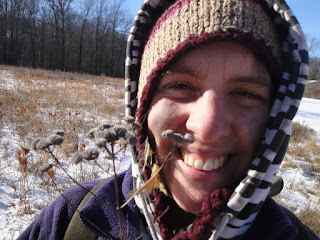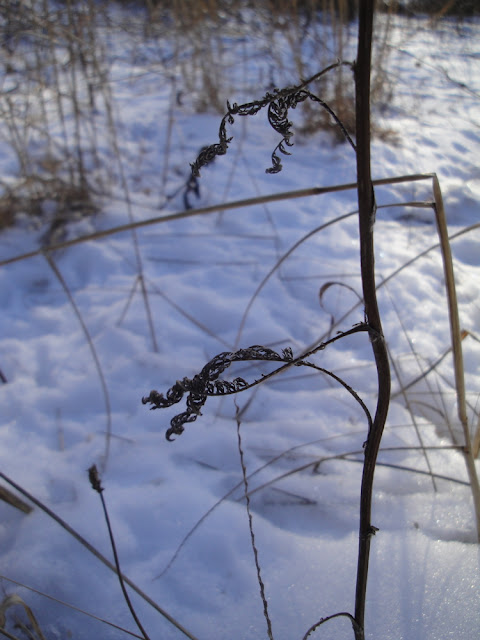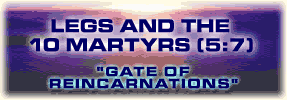http://lancasterfarmacy.blogspot.com/search?updated-min=2011-01-01T00:00:00-08:00&updated-max=2012-01-01T00:00:00-08:00&max-results=14
We had a large group of participants attend this workshop that we offered as part of our Fall Series. Casey talked about foraging for nuts and the many trips to the woods he would go to collect (making sure he was picking the right kind of Shagbark nuts not Pignut Hickory since they are very bitter). Since we like to put the "work" into our workshops we had everyone help us break up the basket of nuts we had. We naturally fell into a circle formation and everyone assumed a working role in pounding out the meat of each nut to later be boiled. It is a great collective project and the processing flies by when there are good people to share stories with. After bringing the nut meat to a boil over the hot fire coals, we enjoyed this creamy thick sweet nut flavored drink on this gorgeous fall day at Lancaster Farmacy! It is our favorite fall beverage since it is a delicious rich hot drink. We sweeten it with maple syrup. Hickory nuts contain great fiber, magnesium and thiamine. They a good source for carbohydrates, natural oils, unsaturated fats (the good kind) and protein.
Blessed Thistle Seeds
Over the winter we have been planning and anticipating the day we would be sowing our seeds in our dear farmer friend's greenhouse at Riverview Organics. Casey and I spent many winter retreats paging through heirloom seed catalogs and making decisions for the things we are most excited to grow and offer through our CSM and the coop. It feels like so long ago that the snow surrounded us, insulating sound into quiet stillness. Even though it has been in the 30s this week, green has been poking itself through the browns of wet spring, chickweed is thicker than ever, the nettles beginning to spread its leaves, spring garlic forming its tufts in early pastures and woods, and the woodcocks are performing their spiral mating ritual which we love to watch. These are just a few signs of early spring and so much more is coming...
Over the winter we have been planning and anticipating the day we would be sowing our seeds in our dear farmer friend's greenhouse at Riverview Organics. Casey and I spent many winter retreats paging through heirloom seed catalogs and making decisions for the things we are most excited to grow and offer through our CSM and the coop. It feels like so long ago that the snow surrounded us, insulating sound into quiet stillness. Even though it has been in the 30s this week, green has been poking itself through the browns of wet spring, chickweed is thicker than ever, the nettles beginning to spread its leaves, spring garlic forming its tufts in early pastures and woods, and the woodcocks are performing their spiral mating ritual which we love to watch. These are just a few signs of early spring and so much more is coming...
For our seeds this season, we chose many native plants that we feel a responsibility to grow on our land since we want to share them with others than ourselves which we typically forage. Every seed has its own needs, conditions and characteristics which makes this a wild array of diversity in our seed collection. With my love for art, I've always regarded nature as my favorite artist, opening each packet of seeds is like going to a show and appreciating unique textures, shapes, color, and energy. We have over 60 varieties of herbs, 50 of produce and 40 of flowers, making that 150 total varieties! Each seed we plant feels like our baby and we can't wait to see all of them grow healthy and strong and form new relationships to each one.
We are animals
Who says winter is a time for seclusion, slumber, and consumption?
The foxes are on the side of the fields hugging the brush as they hurriedly scamper about looking for an unsuspecting meadow vole or some other source of energy. The snow geese happily honk in unison as they search for any sign of unfrozen water. The wind is painting with a paintbrush of tiny dried goldenrod flowers creating long arcing shapes in the white fluffy crystals. Reflecting on the growing season we share a warming dried tea blend of lavender, chamomile, and chaga. A biting numbing cold blows across the meadow. Coyote tracks crisscross through the frozen ponds and disappear into the cattail marsh. This is the coldest season of the year. A time for identifying the unique dried shapes of winter wildflowers, a time when wood frogs freeze solid, a time for hibernation, a time for trees to sleep, a time for harnessing our inner strength to destroy the confines of our domestication. We are animals. We are humans. We have unnatural laws, rules, sexual numbness, monetary struggles, addiction, hate, substance abuse, words that hurt, looks that kill. We have the luxury of consumption, this is one of our “luxuries” that keep us blind to the natural ways of the world. We are animals. We can harness our inner desires and create a world our grandchildren will be proud of. Our reclaimed wildness will comfort the earth and her beings. This is healing, for ourselves, others, and the planet. We are animals.
Seedbox: Ludwigia Alternifolia
I have been wanting to share this cool plant with eli since last winter. A perennial that shakes with the wind spilling its golden seeds out the one hole on the top of its box (hence its name). The little woody boxes looks like something that was crafted by gnomes. Grows 1-3 feet in wet meadows. In the primrose family and in the summer sports yellow petaled flowers. You will not have a hard time identifying this unique plant.
The last fruit on this long forgotten pear tree... We have been enjoying the fruit and juice of these feral pears for the past few years. Its funny how we often get soooo many stares from passerby as we gorge ourselves on this sweet fruit...
Who says winter is a time for seclusion, slumber, and consumption?
The foxes are on the side of the fields hugging the brush as they hurriedly scamper about looking for an unsuspecting meadow vole or some other source of energy. The snow geese happily honk in unison as they search for any sign of unfrozen water. The wind is painting with a paintbrush of tiny dried goldenrod flowers creating long arcing shapes in the white fluffy crystals. Reflecting on the growing season we share a warming dried tea blend of lavender, chamomile, and chaga. A biting numbing cold blows across the meadow. Coyote tracks crisscross through the frozen ponds and disappear into the cattail marsh. This is the coldest season of the year. A time for identifying the unique dried shapes of winter wildflowers, a time when wood frogs freeze solid, a time for hibernation, a time for trees to sleep, a time for harnessing our inner strength to destroy the confines of our domestication. We are animals. We are humans. We have unnatural laws, rules, sexual numbness, monetary struggles, addiction, hate, substance abuse, words that hurt, looks that kill. We have the luxury of consumption, this is one of our “luxuries” that keep us blind to the natural ways of the world. We are animals. We can harness our inner desires and create a world our grandchildren will be proud of. Our reclaimed wildness will comfort the earth and her beings. This is healing, for ourselves, others, and the planet. We are animals.
Eli with some dried Mountain Mint: Pycnanthemum Spp.... We found this growing under wild bee bergamont and surrounded by joe pye weed. When crushed the small gray flower heads smell strongly of mint.
Seedbox: Ludwigia Alternifolia
I have been wanting to share this cool plant with eli since last winter. A perennial that shakes with the wind spilling its golden seeds out the one hole on the top of its box (hence its name). The little woody boxes looks like something that was crafted by gnomes. Grows 1-3 feet in wet meadows. In the primrose family and in the summer sports yellow petaled flowers. You will not have a hard time identifying this unique plant.
The last fruit on this long forgotten pear tree... We have been enjoying the fruit and juice of these feral pears for the past few years. Its funny how we often get soooo many stares from passerby as we gorge ourselves on this sweet fruit...
Teasel:Dipsacus SylvestrisA biennial that can grow over 7ft tall. With a very large egg shaped spiky flower head it looms above other dried plants and remains strong during harsh winds.The flower essence has been used to treat Lyme disease. Teasel root helps you with joint and tendon issues, muscle pain and inflammation. We look forward to making a teasel tincture this summer.
Yarrow:Achillea Millefolium
AKA Natures Stitches... We decided to forgo the flower head and focus on these wondrous dried lacy leaves that are clinging onto the stalk. We pulled one out of the ground to admire and found some small green leaves that were hiding under the snow. We ate every last green leaf at the base of the stalk that we could find, reminiscing its bitterness.
AKA Natures Stitches... We decided to forgo the flower head and focus on these wondrous dried lacy leaves that are clinging onto the stalk. We pulled one out of the ground to admire and found some small green leaves that were hiding under the snow. We ate every last green leaf at the base of the stalk that we could find, reminiscing its bitterness.
Mullein: Verbascum ThapsusThis spike that forms in its second year holds hundreds of seeds. Mullein a useful plant for healing burns, swelling, and ear problems can grow over 6 feet. The whole plant has a woolly like texture over the stalk and leaves. Hummingbirds have been known to use this "wool" to line their nests and native americans stuffed their moccasins with the felt textured leaves. Notice these majestic stalks along roadways, abandoned lots, and meadows...













